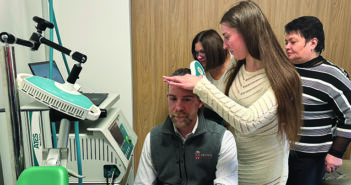Researchers develop evidence-based program to save lives and reduce strain on mental health care system.
For every person who died by suicide in 2020, 25 more made an attempt, according to the US Centers for Disease Control and Prevention. But a new book, based on 15 years of clinical work and research by three Brown professors, presents a roadmap to reduce suicidal behavior in high-risk patients before it’s too late.
“In the two decades prior to the COVID-19 pandemic, there was a steady rise in the rate of suicide, despite the growing armamentarium of treatment approaches for suicide and suicide risk factors,” says Lauren Weinstock, PhD, a professor of psychiatry and human behavior.
In response, Weinstock collaborated with fellow professors of psychiatry and human behavior Ivan W. Miller, PhD, and Brandon Gaudiano, PhD, to develop the Coping Long-Term with Active Suicide Program (CLASP) in 2005. In 2014, the group launched a pilot study of the program at Butler Hospital, a Brown teaching affiliate.
For patients admitted to hospitals after suicide attempts, CLASP acts as a bridge between acute care and outpatient treatment in the community, Miller says. This transition period can be a tenuous time for people in crisis; suicide rates after discharge from psychiatric hospitals are approximately 15 times higher than the national rate, according to a 2017 analysis in JAMA Psychiatry.
CLASP, which is administered by treatment advisers who have a master’s-level degree in a mental health or related field, combines in-person counseling sessions before hospital discharge with telephone check-ins for several months thereafter, Miller says, and enlists the support of patients’ family, friends, or significant others. This approach reduces barriers to care including transportation, cost of treatment, and timing of appointments. But CLASP’s predominant objective is to instill hope in patients by prompting them to describe their personal values and set forward-thinking goals.
“We thought an approach that focused on values would be most effective and useful for people struggling with suicidal behavior,” Gaudiano says. “The goal is to help patients build a life worth living, in addition to suicide prevention.”
Their book, The Coping Long Term with Active Suicide Program (CLASP): A Multi-Modal Intervention for Suicide Prevention, is a resource for clinicians, researchers, and mental health practitioners who are interested in implementing a cost-effective and proven suicide prevention intervention. Published by Oxford University Press as part of the Treatments That Work series, the book describes the research support for the program and also provides implementation guidelines for clinical practice.
In an interview, Gaudiano, Miller, and Weinstock discuss the factors that make CLASP unique and effective as well as why the new clinician guide arrives at such a critical moment for practitioners and the public alike.




